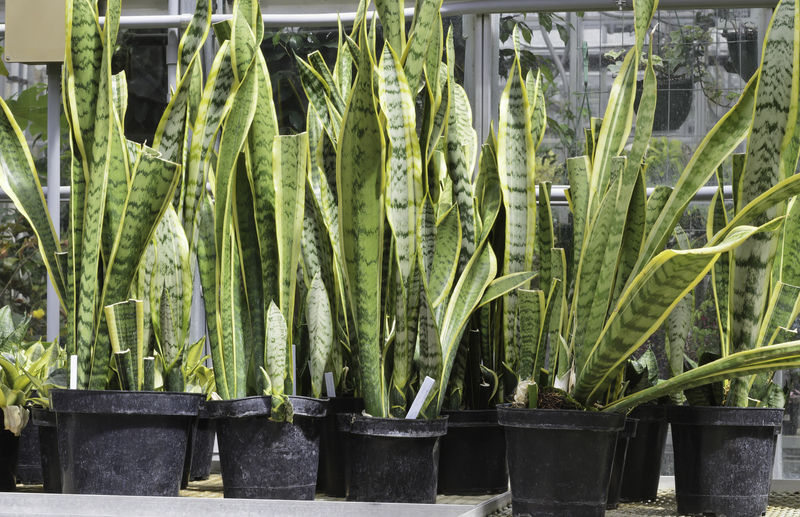Vertical Gardening Tips for Small Spaces
Posted on 07/09/2025
Vertical Gardening Tips for Small Spaces
Living in a city or a home with limited outdoor space shouldn't stop you from enjoying a lush and productive garden. Vertical gardening offers an innovative and space-efficient way to bring bountiful greenery, fresh herbs, and even vegetables into small spaces, balconies, patios, and urban apartments. In this comprehensive guide, we'll share practical vertical gardening tips for small spaces, explore creative ideas, and provide expert advice to help you turn your walls, fences, and nooks into verdant garden oases.

Why Choose Vertical Gardening?
Urban dwellers and anyone with a modest-sized yard often struggle with space constraints. Vertical garden solutions maximize growing area by taking advantage of unused vertical surfaces such as walls, fences, and even indoor corners. Here are some compelling reasons to embrace vertical gardening:
- Maximizes limited space: Perfect for balconies, patios, and compact backyards.
- Enhances privacy: Lush green walls and trellises can serve as natural screens.
- Improves air quality: Vertical gardens help filter indoor and outdoor air.
- Reduces heat and noise: Dense foliage acts as insulation and a sound buffer.
- Increases yield potential: Grow more crops by stacking up instead of spreading out.
- Adds visual appeal: Vertical gardens can transform dull walls into living art.
Getting Started: Essential Vertical Gardening Tools and Materials
Before diving into your vertical gardening project, you'll need to gather some key supplies and materials. Consider your space, skill level, and style preferences, and explore these popular options:
- Wall planters: Modular pockets, hanging pots, and rack systems designed for easy attachment to walls or fences.
- Trellises and lattices: Ideal for supporting climbing plants like peas, beans, and cucumbers.
- Pallet gardens: Repurposed wooden pallets fitted with landscaping fabric and filled with soil for rustic vertical displays.
- Gutter gardens: Old rain gutters mounted horizontally for growing shallow-rooted herbs and greens.
- Shelf gardens: Staggered shelves or tiered plant stands for a multi-layered effect.
- Tower gardens: Pre-made or DIY stackable containers that take advantage of vertical space.
Vertical Gardening Kits: Ready-to-Use Solutions
For beginners or those seeking convenience, vertical gardening kits provide everything needed to get started. These kits typically include plant containers, mounting hardware, irrigation systems, and detailed instructions. Popular brands offer solutions for indoor vertical gardens, living walls, and small balcony setups.
Choosing the Right Plants for Vertical Gardens
Selecting suitable plants is critical for the success of your vertical garden. When planning a small vertical space garden, opt for plants that are compact, lightweight, and well-suited for containers. Here are some top choices:
Best Edible Plants for Vertical Gardening
- Lettuce and salad greens: Grow quickly and thrive in shallow containers.
- Herbs: Basil, mint, parsley, cilantro, thyme, and oregano are perfect for hanging pots or wall planters.
- Strawberries: Compact runners adapt well to pocket or tower gardens.
- Peas and beans: Climbing varieties can scale trellises with ease and produce generously.
- Chilies and peppers: Small fruiting plants flourish in vertical containers.
- Tomatoes (cherry or dwarf types): Grow in hanging pots or with support cages for a vertical harvest.
Top Ornamental Plants for Vertical Walls
- Succulents: Low-maintenance, drought-tolerant, and diverse in color and shape.
- Ferns: Provide lush, green textures for shaded locations.
- Pothos and philodendron: Fast-growing, trailing vines ideal for indoor vertical gardens.
- Ornamental grasses: Add height and movement to vertical displays.
- Petunias, impatiens, and trailing lobelia: Brighten up walls with vibrant blooms.
Designing Your Vertical Garden in Small Spaces
Effective vertical garden design involves more than just hanging plants up high. To create a thriving and visually appealing setup, keep these tips in mind:
1. Assess Sunlight and Microclimates
Observe how much sunlight your chosen garden site receives each day. Most edible plants require at least 4-6 hours of sunlight, while ferns and shade-lovers do best in partial or filtered shade. Balcony gardens may have unique microclimates due to surrounding walls and wind exposure, so select plants accordingly.
2. Plan for Watering and Maintenance
Vertical gardens tend to dry out faster than traditional beds, particularly in hot weather. Efficient irrigation--from drip systems to self-watering pots--can make all the difference. Consider installing a simple automated watering system or plan to water daily during peak heat. Always position taller, thirstier plants at the bottom where water run-off collects, and drought-tolerant varieties at the top.
3. Make Use of Every Inch
Think creatively when planning small-space vertical gardens. Use corner shelves, hang plant pockets on balcony railings, and stack pots for a tiered look. Even a sunny kitchen wall can house a thriving herb garden using magnetic planters or clever hanging racks.
Step-by-Step Guide to Setting Up a Vertical Garden
- Choose your vertical gardening system: Pick from wall-mounted planters, trellises, shelves, or a mix of options to suit your environment.
- Measure your space: Ensure your planters and support structures fit snugly and safely in the allotted area.
- Select your plants: Mix edibles and ornamentals for maximum beauty and harvest potential.
- Prepare planting containers: Use a quality, lightweight potting mix and ensure good drainage by adding holes or using specialized liners.
- Install mounting systems: Securely attach brackets, hooks, or screws according to weight and wall material.
- Arrange and plant: Place plants in pockets, shelves, or containers--starting with the largest or most sun-loving at the top.
- Set up irrigation: Position drip lines, wicking systems, or self-watering containers if available.
- Maintain and monitor: Check moisture and nutrient levels regularly, and rotate plants for even sun exposure.
Creative Vertical Gardening Ideas for Tiny Spaces
- Hanging shoe organizer gardens: Repurpose fabric shoe racks by filling the pockets with soil and planting herbs or flowers.
- Ladder gardens: Lean an old wooden ladder against a wall and place pots on each rung for a rustic, tiered look.
- DIY pallet planters: With some landscape fabric and creativity, you can transform a used pallet into a pocketed planter for a wall or fence.
- Gutter herb garden: Attach sections of rain gutter horizontally to a fence or wall for easy access to fresh herbs and greens.
- Stackable pots tower: Use specially designed pots that stack on top of one another, saving precious floor space.
- Macrame plant hangers: Suspend small pots from the ceiling or balcony rafters for a boho-inspired green nook.
Maintenance and Care for Small Vertical Gardens
1. Watering Strategies
As vertical gardens lose moisture quickly, check the soil daily during warm weather. Water at the base of each plant to minimize waste and avoid wetting foliage. For busy plant parents, self-watering systems or water reservoirs provide a low-maintenance solution.
2. Fertilizing and Feeding
Because nutrients may leach out faster in vertical containers, supplement with a balanced liquid fertilizer every 2-4 weeks. Slow-release granules can also be mixed into the soil at planting time.
3. Pruning and Replanting
Regularly trim and deadhead ornamental plants to promote bushy growth and prevent overcrowding. Harvest herbs and greens frequently to encourage new leaves. Replace annuals and weak plants each season for a consistently healthy display.
4. Watching for Pests and Diseases
Vertical gardens are less likely to suffer from traditional garden pests, but keep an eye out for aphids, spider mites, and mildew. Use organic sprays or simply rinse affected leaves with water when necessary.
Eco-Friendly and Sustainable Vertical Gardening
Make your compact garden even greener by using sustainable practices:
- Opt for recycled containers: Upcycle jars, cans, bottles, or old wooden crates as planters.
- Harvest rainwater: Catch runoff from balconies or rooftops to water your vertical garden.
- Use organic fertilizers: Choose compost, worm castings, or seaweed emulsion for a natural boost.
- Plant native varieties: Choose regionally-adapted plants that require fewer inputs and support pollinators.
Common Mistakes to Avoid in Vertical Gardening
- Overloading walls or fences: Ensure that your support structures can handle the weight of fully-grown, moist plants.
- Poor plant selection: Avoid deep-rooted or tall, top-heavy species that may topple over or struggle in confined spaces.
- Insufficient drainage: Always use containers with adequate drainage holes to prevent root rot.
- Uneven watering: Top containers may dry out faster; monitor moisture levels throughout your garden.
- Ignoring maintenance: Regular pruning, feeding, and pest checks keep your vertical garden healthy and thriving.

FAQs About Vertical Gardening in Small Spaces
Do vertical gardens require special soil?
Yes, it's best to use a lightweight, well-draining potting mix designed for containers. Avoid heavy garden soil, which can become compacted and waterlogged.
Can I grow vegetables in a vertical garden?
Absolutely! Many compact vegetables--such as lettuce, radishes, cherry tomatoes, and dwarf peppers--thrive in vertical setups with adequate sunlight, water, and nutrients.
How much space do I need for a vertical garden?
You can start with as little as 2-3 feet of wall or railing. Even the smallest nook can support a few shelves, pockets, or hanging pots.
How do I keep my vertical plants watered?
Use a drip irrigation system, self-watering containers, or water by hand with a long-spout watering can. Water more frequently during dry, hot periods and always check soil moisture.
Conclusion: Growing Up in Small Spaces
Vertical gardening in small spaces can transform tiny balconies, patios, kitchens, and city corners into thriving green sanctuaries. With the right setup, plant selection, and a little creativity, you can maximize every square inch of your home or yard. Whether you're hoping to grow salad greens, fresh herbs, or simply fill your environment with nature's beauty, these vertical garden tips and ideas will help you succeed.
Ready to get started? Bring your gardening dreams to new heights, and enjoy the many benefits of vertical gardening--even in the smallest of spaces!

